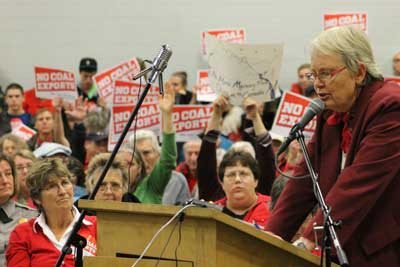State and federal regulators announced today that the environmental impacts of what would be the largest coal export facility on the West Coast will undergo a large-scale review that extends well beyond the site of the proposed Gateway Pacific Terminal at Cherry Point.
In a joint press release issued Wednesday, July 31, the U.S. Army Corps of Engineers, Washington state Department of Ecology and Whatcom County said that the scope of the GPT environmental impact state will include “direct effects at the site and evaluate a broad range of indirect and cumulative impacts likely to occur within and beyond Washington.”
The three agencies together are producing the EIS for the controversial GPT project, which, at full capacity, could process and export up to 48 million tons of coal bound for Asian markets a year. In addition to a detailed study of increased rail-cargo near Bellingham and Ferndale, as well as in other areas of the state, the EIS will include as assessment of environmental risks from an increase in shipping traffic in the state’s inland waters and through the San Juans.
An additional 18 deep-draft “Capesize” cargo ships are expected to arrive or depart from the terminal each week, according to Ecology. A “draft” of the final EIS is expected to be complete in two years.
The decision to broaden the scope of the project’s environmental impacts drew praise from local environmental advocates.
“We are pleased to see that the Gateway Pacific Scoping Report included issues that are critical to islanders including marine traffic, human health, green house gasses, and the cumulative impacts of regional coal exports,” said Stephanie Buffum, executive director of Friends of the San Juans. “We appreciate the leadership of Department of Ecology and the governor for looking at the longterm health and environmental impacts associated with this project.”
State Sen. Kevin Ranker, D-Orcas Island, applauded the scope of the EIS as well.
“This is exactly the decision we have been seeking for several years now since we wrote the first comment letter on this subject,” Ranker said.”There are significant questions regarding this project and by the time this study is concluded we should have a much greater understanding of the long- and short-term impacts of all aspects of this terminal.
If approved, the $650 million Gateway Terminal would be the largest bulk export facility on the West Coast, perhaps in the nation. At full capacity, it would be capable of exporting up to 54 million metric tons of coal and other commodities a year from the plant that Pacific International Terminals, a subsidiary of SSA Marine, which operates an export terminal at the Port of Seattle, and others worldwide, is seeking to build at Cherry Point, just north of Bellingham.
While the Corps of Engineers must follow the National Environmental Policy Act in conducting its part of the joint environmental review, Whatcom County and Ecology are guided by the State Environmental Policy Act. Ecology and Whatcom determined that under SEPA the EIS should include an examination of impacts on “earth, air, water, plants and animals, energy and natural resources, environmental health, land and shoreline use, transportation, and public services and utilities.”
Supporters of the project claim the extent of the EIS is unprecedented and that it could discourage companies from investing in future projects that bring economic benefits to the state and its citizens.
“This expanded review casts doubt on Washington state’s ability to invest in any major port infrastructure projects,” said John McLaurin, president of the Pacific Merchant Shipping Association. “Trade is a driver for our economy, and for our ports and waterfronts and now is not the time to undermine our opportunities to expand trade.”
More than 125,000 comments were submitted during a series of EIS “scoping” meetings conducted at various parts of the state by the three regulatory agencies, including one on San Juan Island, in which a standing-room-only crowd packed Friday Harbor High School’s Hall Gym.




